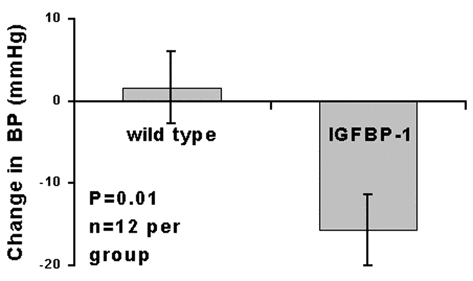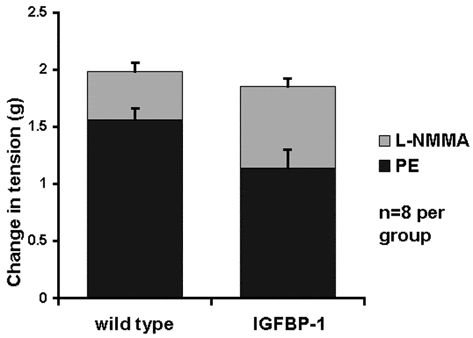Insulin is a physiological vasodilator via release of endothelial nitric oxide (NO). Insulin resistance and chronic hyperinsulinaemia are associated with hypertension and endothelial dysfunction. Co-ordinate interactions between insulin, insulin-like growth factors (IGFs), and their binding proteins (IGFBPs) are important in determining insulin sensitivity in vivo. We previously demonstrated postprandial hyper-insulinaemia in IGFBP-1 transgenic mice, suggesting impaired insulin sensitivity (Crossey et al. 2000). We have now assessed basal endothelial function and blood pressure, and vascular responses to carbohydrate loading, in these mice.
All studies were conducted in accordance with Home Office regulations for animal experimentation. Tail cuff blood pressure was recorded and glucose and insulin levels were measured in the fasting state and following a glucose challenge (1 mg g-1 I.P.) in conscious mice. Animals were then humanely killed and thoracic aortic rings were studied in vitro for (i) constriction to phenylephrine (PE; 1 nM to 10 µM), (ii) maximal constriction to the NO synthase inhibitor L-NMMA (0.1 mM, 30 min), and (iii) relaxation to acetylcholine (ACh 1 nM to 10 µM) and sodium nitroprusside (SNP 0.01 nM to 10 µM). Mean ± S.E.M. data were analysed by Student’s t test. P < 0.05 was considered significant. Fasting blood glucose and insulin levels were similar in transgenic and wild-type mice, but plasma insulin was significantly higher in IGFBP-1 mice 30 min after glucose challenge (1.7 ± 0.32 versus 0.69 ± 0.08 µg l-1; P < 0.05). Glycaemic control, assessed by I.P. glucose and insulin tolerance tests, was similar in the two groups. Fasting systolic blood pressure was 132 ± 5 mmHg in IGFBP-1 mice and 124 ± 5 mmHg in controls (P = 0.2). After glucose challenge, however, blood pressure fell significantly in IGFBP-1 mice but not controls (Fig. 1). Aortic ring sensitivity to PE was similar in both groups (pEC50 6.85 ± 0.04 vs. 6.83 ± 0.07), but maximal tension was lower in IGFBP-1 mice (Fig. 2). Basal NO release (maximal response to L-NMMA) was increased in IGFBP-1 mice (Fig. 2). Relaxation to ACh and SNP was similar in both groups (pEC50: 7.4 ± 0.1 vs. 7.5 ± 0.1 for ACh; 8.5 ± 0.1 vs. 8.6 ± 0.1 for SNP, n = 6 in all groups). Thus transient post-prandial hyperinsulinaemia in IGFBP-1 transgenic mice is associated with relative hypotension. There is no evidence of hypertension or endothelial dysfunction in these animals but basal vascular NO activity is increased.
This work was supported by the British Heart Foundation and Diabetes UK.
 View larger image [new window] |
| Figure 1. Systolic blood pressure response to glucose challenge. |
 View larger image [new window] |
| Figure 2. Response of aortic rings to sequential addition of PE (10 µM; P = 0.04 between groups) and L-NMMA (0.1 mM; P = 0.02 between groups) |


